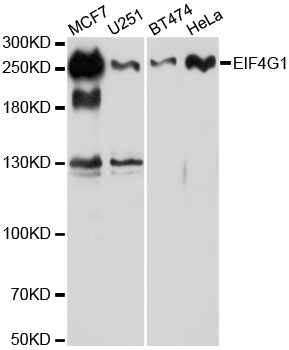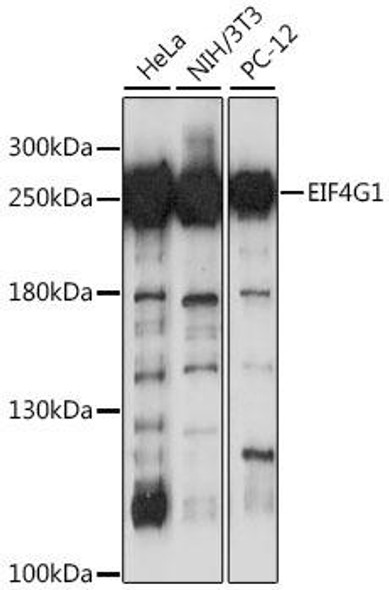Immunology Antibodies 2
Anti-EIF4G Antibody (CAB6086)
- SKU:
- CAB6086
- Product Type:
- Antibody
- Reactivity:
- Human
- Host Species:
- Rabbit
- Isotype:
- IgG
- Antibody Type:
- Polyclonal Antibody
- Research Area:
- Immunology
Description
| Antibody Name: | Anti-EIF4G Antibody |
| Antibody SKU: | CAB6086 |
| Antibody Size: | 20uL, 50uL, 100uL |
| Application: | WB |
| Reactivity: | Human |
| Host Species: | Rabbit |
| Immunogen: | A synthetic peptide corresponding to a sequence within amino acids 400-500 of human EIF4G (NP_886553.3). |
| Application: | WB |
| Recommended Dilution: | WB 1:500 - 1:1000 |
| Reactivity: | Human |
| Positive Samples: | MCF7, U251, BT474, HeLa |
| Immunogen: | A synthetic peptide corresponding to a sequence within amino acids 400-500 of human EIF4G (NP_886553.3). |
| Purification Method: | Affinity purification |
| Storage Buffer: | Store at -20'C. Avoid freeze / thaw cycles. Buffer: PBS with 0.02% sodium azide, 50% glycerol, pH7.3. |
| Isotype: | IgG |
| Sequence: | PEEL LNGA PSPP AVDL SPVS EPEE QAKE VTAS MAPP TIPS ATPA TAPS ATSP AQEE EMEE EEEE EEGE AGEA GEAE SEKG GEEL LPPE STPI PANL SQNL E |
| Gene ID: | 1981 |
| Uniprot: | Q04637 |
| Cellular Location: | |
| Calculated MW: | 154kDa/158kDa/166kDa/171kDa/175kDa/176kDa |
| Observed MW: | 260kDa |
| Synonyms: | EIF4G1, EIF-4G1, EIF4F, EIF4G, EIF4GI, P220, PARK18 |
| Background: | The protein encoded by this gene is a component of the multi-subunit protein complex EIF4F. This complex facilitates the recruitment of mRNA to the ribosome, which is a rate-limiting step during the initiation phase of protein synthesis. The recognition of the mRNA cap and the ATP-dependent unwinding of 5'-terminal secondary structure is catalyzed by factors in this complex. The subunit encoded by this gene is a large scaffolding protein that contains binding sites for other members of the EIF4F complex. A domain at its N-terminus can also interact with the poly(A)-binding protein, which may mediate the circularization of mRNA during translation. Alternative splicing results in multiple transcript variants, some of which are derived from alternative promoter usage. |
| UniProt Protein Function: | eIF4G: Component of the protein complex eIF4F, which is involved in the recognition of the mRNA cap, ATP-dependent unwinding of 5'-terminal secondary structure and recruitment of mRNA to the ribosome. eIF4F is a multi-subunit complex, the composition of which varies with external and internal environmental conditions. It is composed of at least EIF4A, EIF4E and EIF4G1/EIF4G3. Interacts with eIF3, mutually exclusive with EIF4A1 or EIFA2, EIF4E and through its N-terminus with PAPBC1. Interacts through its C-terminus with the serine/threonine kinases MKNK1, and with MKNK2. Appears to act as a scaffold protein, holding these enzymes in place to phosphorylate EIF4E. Non-phosphorylated EIF4EBP1 competes with EIF4G1/EIF4G3 to interact with EIF4E; insulin stimulated MAP-kinase (MAPK1 and MAPK3) phosphorylation of EIF4EBP1 causes dissociation of the complex allowing EIF4G1/EIF4G3 to bind and consequent initiation of translation. EIF4G1/EIF4G3 interacts with PABPC1 to bring about circularization of the mRNA. Rapamycin can attenuate insulin stimulation mediated by FKBPs. Interacts with EIF4E3. Interacts with CIRBP and MIF4GD. Interacts with rotavirus A NSP3; in this interaction, NSP3 takes the place of PABPC1 thereby inducing shutoff of host protein synthesis. Interacts with RBM4. Belongs to the eIF4G family. 5 isoforms of the human protein are produced by alternative splicing. |
| UniProt Protein Details: | Protein type:RNA-binding; Translation; Translation initiation Chromosomal Location of Human Ortholog: 3q27.1 Cellular Component: membrane; eukaryotic translation initiation factor 4F complex; cytosol Molecular Function:protein binding; translation factor activity, nucleic acid binding; translation initiation factor activity Biological Process: poly(A) tail shortening; cellular protein metabolic process; translation; viral reproduction; cytokine and chemokine mediated signaling pathway; translational initiation; insulin receptor signaling pathway; mRNA catabolic process, nonsense-mediated decay; gene expression; regulation of translational initiation; mRNA catabolic process, deadenylation-dependent decay |
| NCBI Summary: | The protein encoded by this gene is a component of the multi-subunit protein complex EIF4F. This complex facilitates the recruitment of mRNA to the ribosome, which is a rate-limiting step during the initiation phase of protein synthesis. The recognition of the mRNA cap and the ATP-dependent unwinding of 5'-terminal secondary structure is catalyzed by factors in this complex. The subunit encoded by this gene is a large scaffolding protein that contains binding sites for other members of the EIF4F complex. A domain at its N-terminus can also interact with the poly(A)-binding protein, which may mediate the circularization of mRNA during translation. Alternative splicing results in multiple transcript variants, some of which are derived from alternative promoter usage. [provided by RefSeq, Aug 2010] |
| UniProt Code: | Q04637 |
| NCBI GenInfo Identifier: | 294862538 |
| NCBI Gene ID: | 1981 |
| NCBI Accession: | Q04637.4 |
| UniProt Secondary Accession: | Q04637,O43177, O95066, Q5HYG0, Q6ZN21, Q8N102, D3DNT2 D3DNT4, D3DNT5, E9PFM1, G5E9S1, |
| UniProt Related Accession: | Q04637 |
| Molecular Weight: | 175,491 Da |
| NCBI Full Name: | Eukaryotic translation initiation factor 4 gamma 1 |
| NCBI Synonym Full Names: | eukaryotic translation initiation factor 4 gamma, 1 |
| NCBI Official Symbol: | EIF4G1 |
| NCBI Official Synonym Symbols: | P220; EIF4F; EIF4G; EIF4GI; PARK18; EIF-4G1 |
| NCBI Protein Information: | eukaryotic translation initiation factor 4 gamma 1; EIF4-gamma; eIF-4-gamma 1; eucaryotic translation initiation factor 4G |
| UniProt Protein Name: | Eukaryotic translation initiation factor 4 gamma 1 |
| UniProt Synonym Protein Names: | p220 |
| Protein Family: | Eukaryotic translation initiation factor |
| UniProt Gene Name: | EIF4G1 |
| UniProt Entry Name: | IF4G1_HUMAN |
View AllClose





![Anti-EIF4G2 Antibody (CAB19990)[KO Validated] Anti-EIF4G2 Antibody (CAB19990)[KO Validated]](https://cdn11.bigcommerce.com/s-rd6ounxcu2/images/stencil/590x590/products/56154/61336/anti-eif4g2-antibody-cab19990ko-validated__12970__25009.1706533775.jpg?c=1)

